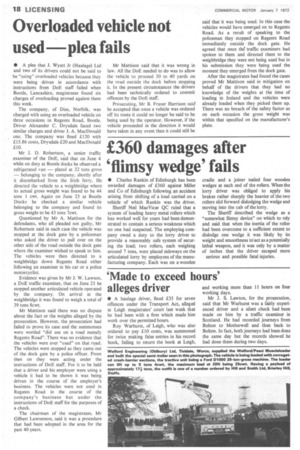Overloaded vehicle not used plea fails
Page 20

If you've noticed an error in this article please click here to report it so we can fix it.
• A plea that J. Wyatt Jr (Haulage) Ltd and two of its drivers could not be said to be "using" overloaded vehicles because they were being driven in accordance with instructions from DoE staff failed when Bootle, Lancashire, magistrates found six charges of overloading proved against them this week.
The company, of Diss, Norfolk, was charged with using an overloaded vebicle on three occasions in Regents Road, Bootle. Driver Alexander C. Drysdale faced two similar charges and driver J. A. MacDonald one. The company was fined £120 with £15.86 costs, Drysdale £20 and MacDonald £10.
Mr J. D. Robertson, a senior traffic examiner of the DoE, said that on June 4 while on duty at Bootle docks he observed a refrigerated van — plated at 32 tons gross — belonging to the company, shortly after it disembarked from the Irish ferry. He directed the vehicle to a weighbridge where its actual gross weight was found to be 44 tons 1 cwt. Again on June 25 at Bootle Docks he checked a similar vehicle belonging to the company and found its gross weight to be 43 tons 7cwt.
Questioned by Mr A. Mattison for the defendants, who all pleaded not guilty, Mr Robertson said in each case the vehicle was stopped at the dock gate by a policeman who asked the driver to pull over on the other side of the road outside the dock gate where the examiner wished to speak to him. The vehicles were then directed to a weighbridge down Regents Road either following an examiner in his car or a police motorcyclist.
Evidence was given by Mr J. W. Lawson, a DoE traffic examiner, that on June 25 he stopped another articulated vehicle operated by the company. On arrival at the weighbridge it was found to weigh a total of 39 tons 8cwt.
Mr Mattison said there was no dispute about the fact or the weights alleged by the prosecution. However, the prosecution had failed to prove its case and the summonses were worded "did use on a road namely Regents Road". There was no evidence that the vehicles were ever "used" on that road. The vehicles were stopped as they came out of the dock gate by a police officer. From then on they were acting under the instructions of DoE staff. For it to be held that a driver and his employer were using a vehicle it had to be shown it was being driven in the course of the employer's business. The vehicles were not used in Regents Road in the course of the company's business but under the instructions of DoE staff for the purposes of a check.
The chairman of the magistrates, Mr Gilbert Lawrenson, said it was a procedure that had been adopted in the area for the past 40 years. Mr Mattison said that it was wrong in law. All the DoE needed to do was to allow the vehicle to proceed 30 to 40 yards on the road outside the dock before stopping it. In the present circumstances the drivers had been technically ordered to commit offences by the DoE staff.
Prosecuting, Mr B. Fraser Harrison said' he accepted that once a vehicle was ordered off its route it could no longer be said to be being used by the operator. However, if the vehicle proceeded in the direction it would have taken in any event then it could still be
said that it was being used. In this case the vehicles would have emerged on to Regents Road. As a result of speaking to the policeman they stopped on Regents Road immediately outside the dock gate. He agreed that once the traffic examiners had spoken to them and directed them to the weighbridge they were not being used but in his submission they were being used the moment they emerged from the dock gate.
After the magistrates had found the cases proved Mr Mattison said in mitigation on behalf of the drivers that they had no knowledge of the weights at the time of loading in Ireland and the vehicles were already loaded when they picked them up. There was no breach of the safety factor as on each occasion the gross weight was within that specified on the manufacturer's plate.




















































































